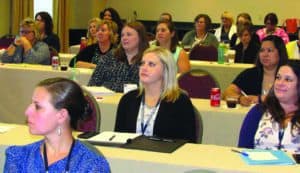 Resources abound for women looking to advance their banking careers
Resources abound for women looking to advance their banking careers
As she wends her way through Illinois calling on banks of many sizes, correspondent banker Marlene Luther, now 66, catalogs the ways the industry has changed for women since she started in banking. In the 1970s, pantyhose and closed-toe shoes were mandated attire and management was homogeneously male. Over time, she saw increasing numbers of women at meetings sponsored by state banking associations, yet many sat doe-eyed and silent. A few still do.
“In some ways the path to leadership for women is easier today, especially at the larger banks that recognize the value of diversity,” said Luther, vice president at Midwest Independent Bank, Jefferson City, Mo., and 2017 chair of the Illinois Bankers Association’s “Women in Banking” Conference, which was conducted in September. “But I still find bank presidents — both men and women — asking, ‘why do we need a Women in Banking conference?’”
This is an easier question to answer after one looks at the gains women have yet to make into C-suite positions in banking and beyond.
Regina Barr, CEO of Minnesota-based consulting firm Red Ladder, conducts an annual study of senior level positions within the 50 largest U.S. banks. In 2015, women comprised 20.3 percent of executive roles, an increase from 17.9 percent in 2014. During that same time, however, the number of senior management positions declined. “We have to be careful when we look at the data and the industry; we should ask: ‘Is it an artificial increase?’” Barr explained.
Red Ladder’s Women at the Top (WATT) study has its roots in the 1990s, when it was conducted by Financial Women International. Except for the slight bump in 2015, the needle has held steadily at about 17 percent for years. Worse, the most recent WATT study reveals there remain five of these 50 banks — 10 percent — that have no women in top management.
Women, who comprise nearly 60 percent of college graduates, are vastly underrepresented at the top of corporations. In the United States, women have a 14 percent representation on executive committees and a 16 percent representation on corporate boards, according to a 2013 report on gender diversity conducted by McKinsey & Company. A Peterson Institute for International Economics 2014 survey of 22,000 firms globally found that 60 percent of surveyed firms had no female board members, just more than half had no female C-suite executives, and fewer than 5 percent had a female CEO. At the same time, the survey looked at profitability and found companies that went from having no women in corporate leadership to a 30 percent female share were associated with a 1 percentage point increase in net margin. A Catalyst study of Fortune 500 companies found that companies with a higher representation of women in senior management financially outperformed companies with proportionally fewer women at the top. The study, sponsored by the BMO Financial Group, used two measures to examine financial performance: Return on Equity (ROE) and Total Return to Shareholders (TRS). After examining 353 companies that remained on the Fortune 500 for four of the five years between 1996 and 2000, it found the group of companies with the highest representation of women on their senior management teams had a 35 percent higher ROE and a 34 percent higher TRS than companies with the lowest female representation.

Women show strength in five dimensions that are specifically tied to performance: personnel development, expectations and rewards, role modeling, inspiration, and participative decision-making. Men apply individualistic decision-making, control and corrective action more frequently than women. Both apply intellectual stimulation and efficient communication equally. And while the Peterson study found women CEOs are no more or less effective than their male counterparts, the value, beyond performance, in developing women into leadership positions is found in how a company is perceived from the outside. Companies that want to recruit and retain top talent need to be perceived as not having gender barriers, underscoring the need to encourage female advancement throughout the corporate structure, not just to the corner office.
“Younger individuals are not looking at banking as a career as they once had,” said Ron Arrigo, executive vice president for education and administration for the Nebraska Bankers Association. The NBA’s third annual “Women in Banking” conference was scheduled for mid-October. Arrigo believes generational issues are as big a challenge in banking as gender issues.
Janice Schramm, vice president of corporate cash management at Hickory Point Bank & Trust, Decatur, Ill., said her bank faces recruiting challenges. “There are so many banks vying for individuals,” Schramm said. “People don’t consider us as their first place to go for employment.”
Barr sees the recruiting challenges facing the industry as women’s greatest chance to advance. “With the skill sets that women bring to the table, their relational and organizational skills, as talent becomes more scarce I believe there will be opportunities.”
Women who want to advance into bank management can find role models at the Independent Community Bankers of America and the American Bankers Association and many state banking associations, including the Indiana Bankers Association, the Illinois Bankers Association and the Wisconsin Bankers Association, where the top executives are female. These and other industry groups present women with multiple opportunities to work on their leadership skills. But the hard work of getting noticed begins and ends at the bank, where ascendency requires perspiration more than inspiration and a willingness to contribute beyond one’s area of expertise.

Women-focused leadership development
The approach to nurturing tomorrow’s leaders varies. Not all state banking associations offer leadership conferences exclusively for women, but many do. Arrigo admitted he was initially hesitant to add an educational conference that was focused only on women to the NBA’s list of conferences. “They’re bankers, right?”
This month, the Indiana Bankers Association will host its inaugural “Banking on Women” conference. “We thought it was the perfect year to introduce this,” said Laurie Rees, IBA vice president of education and training. The association has its first female president and CEO in Amber Van Til; she was promoted when S. Joe DeHaven retired at the end of 2016. Additionally, Annette Russell of Security Federal Savings Bank in Logansport is this year’s association chair and Kristin Marcuccilli, STAR Bank, Fort Wayne, is president of its future leadership division. While the focus of this conference is on leadership training and networking, a session on championing women in business through mentorships is leading IBA to develop a mentor/mentee program which Rees hopes to take state wide.
Kelly Heroux, the 42-year-old president and CEO of Peshtigo National Bank, Peshtigo, Wis., did not attend the Wisconsin Bankers Association’s “Women in Banking” conference this year but she did send one of her employees. WBA has offered a gendered leadership conference since 2006 and Heroux, who attended the Graduate School of Banking at the University of Wisconsin-Madison, sees value in these types of conferences. “Communication styles are what I see as the difference between women and men,” she said. Every day at the bank, Heroux said she thinks about how she will communicate, to both genders, “not only to get buy in but to get them to listen to me.”
The benefit of a single gender leadership conference is repeatedly linked to the differences between how men and women communicate. “Single gender conferences allow women to nurture friendships that become so valuable in this industry,” Luther said. Her decades of experience have taught her such friendships are less likely to happen at mixed gender conferences. “My friends say, ‘I always walk away from this conference so energized.’”
Rose Oswald Poels, president and CEO of the WBA, sees value in networking with people who are similarly situated. For its conference, typically held in the spring, the WBA focuses on topics that are universally applicable to banking careers regardless of gender. “We’ve tried to do a lot in the area of leadership development and it can be broad and general in nature, or specific,” though Oswald Poels admits some women attend to talk to other women about where they are in their career, how they got to where they are, and maybe share some of their frustrations and challenges.
Not every female in banking wants to be segregated by gender when seeking the tools necessary to advance. Kelli Starkey, vice president at Fidelity Bank, Edina, Minn., turned to the Leadership Development Academy offered by the Minnesota Bankers Association, which also offers a separate women’s conference. The year-long academy offers Starkey the opportunity to gain different perspectives on banking and grow her leadership skills. Her cohort is nearly 50 percent female. “As the banking industry changes and the dynamics around employee management changes,” Starkey said, “any information I can glean to help me navigate those changes will help me become a more effective leader.” Starkey recently completed the second of four sessions, which was heavily focused on communications challenges. She said she believes the communications challenges between genders will diminish as more young people enter banking.
Schramm sees millennial women bringing different career expectations to banking “They are highly educated,” she said. Younger women are more attuned to the steps they need to take to advance and they track their careers, she said.
Yet the attendance and enthusiasm for gendered conferences remains. “A lot of women still struggle to move ahead and they appreciate the opportunity to connect and work with other women in banking,” Barr said. Small, family-owned or closely-held banks are mostly managed by men, she said. When women do reach the senior level in banking in these institutions, “it’s often still very isolating.”
“When I greet people at conferences,” Luther said, “I ask them ‘When you go back to your office, who are you going to call when you have a question? You can meet people here who are outside of your market so when you have questions or issues, you have a friend to talk to.’ The connections help a lot.”
“The other part of it is, women need to raise their hand and sometimes they are reluctant,” Barr said. “Sure, a man can tap a woman on the shoulder and say, ‘Hey, I think you’d be good at this,’ but women can say, ‘Hey, I’d be interested in doing this.’” Opportunities for advancement at the bank often come down to areas of expertise. Barr suggests women volunteer in areas outside of their current job or department. “Sometimes you have to lateral around and get a broader array of experience before you can move up,” Barr said.
Lending experience is helpful too. Heroux, who earlier this year took charge of the $196 million northeast Wisconsin bank from her longtime mentor, Keith Shallow, began her career as a customer service representative. She learned operations and then became a lender. “The old way of thinking has always been that you need that loan experience,” Heroux said. “But if you don’t have your pulse on all the other pieces, credit isn’t going to be the only thing that pulls you through. You don’t need to be an expert in every area, but you need to be well-rounded in every area.”
Heroux, who says she learned her work ethic on her parents’ dairy farm, advises women who want to someday lead a bank to communicate confidently and to have a strong work ethic. “You have to put the time in and don’t give up on what you are looking to do just because it isn’t easy the first time.”
